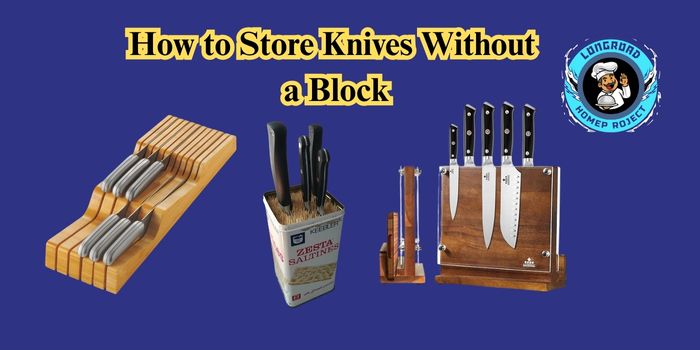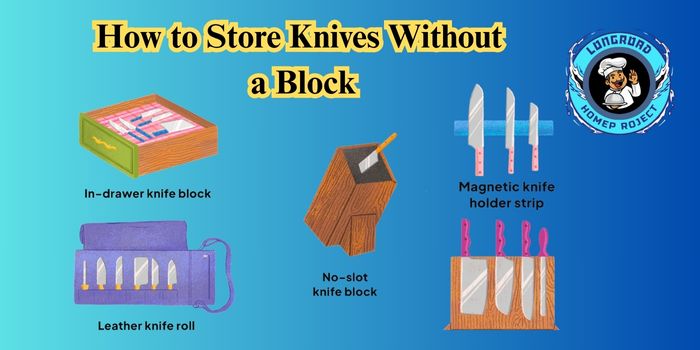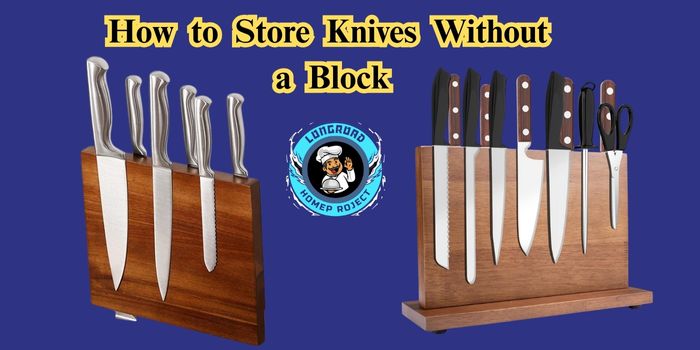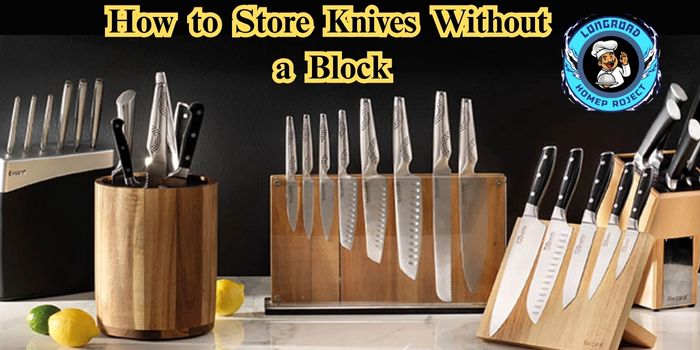As an Amazon Associate I earn from qualifying purchases.
Learning how to store knives without a block became essential for me when I downsized my kitchen last year. Suddenly, I didn’t have the counter space to spare, and my once-loved wooden knife block started feeling bulky, outdated, and—honestly—a little grimy.
Let’s face it: traditional knife blocks aren’t always practical. They take up precious counter real estate, they’re hard to clean (who really gets into those deep slits?), and they limit your flexibility when you add new knives to your collection. On top of that, if you’re aiming for a modern or minimalist kitchen look, a bulky block might not fit your aesthetic.
Whether you’re in a small apartment, managing a busy family kitchen, or just looking for a cleaner, more hygienic alternative, there are smarter and safer ways to store knives without relying on a block.
What You’ll Learn in This Guide
In this article, I’ll walk you through:
- Creative and compact storage ideas for small kitchens
- Safe ways to store knives in drawers (without dulling the blades)
- Sleek wall-mounted options like magnetic strips and rails
- Under-cabinet knife storage for discreet organization
- DIY knife storage hacks for budget-savvy home cooks
- Pros and cons of each method, plus product recommendations
By the end, you’ll have a full toolkit of storage solutions tailored to your space, lifestyle, and cooking habits—no wooden block required.
Why I Ditched My Knife Block (And What I Learned)
When I moved into a smaller apartment, one of the first things I noticed was how limited my counter space had become. I had to make some tough choices about what stayed and what had to go—and surprisingly, my knife block was one of the first to get the boot.
At first, it felt weird. I’d always stored my knives in that big wooden block—it had been with me since my first apartment. But in this tighter kitchen, it was clear: the block was taking up space I couldn’t spare. And honestly, once I started looking more closely, I realized it wasn’t doing my knives (or my kitchen) any favors.
The Hidden Problems with Traditional Knife Blocks
Here’s what I learned after taking a closer look at the old-school knife block:
❌ They’re Bulky
Even a compact block eats up a good chunk of countertop—especially if you have a small prep area. It’s prime real estate that could be used for a cutting board, coffee station, or extra workspace.
❌ They’re Hard to Clean
Crumbs, dust, and even moisture can collect inside the slots of a knife block. And because they’re nearly impossible to clean thoroughly, they can turn into a breeding ground for mold and bacteria over time.
❌ They Can Dull Blades
Pulling knives in and out of wooden or plastic slots can gradually dull the blade edges—especially if the fit is tight or you’re not careful about inserting them.
Safety and Hygiene Come First
The moment I removed the block, my counter felt cleaner, more open, and easier to use. But more importantly, it pushed me to rethink how I store knives safely and hygienically.
Knives are one of the most-used tools in any kitchen—and they’re also one of the most dangerous when stored incorrectly. Loose blades in drawers or dusty knife blocks just don’t cut it (no pun intended).
By exploring new options, I discovered that you can store knives in a way that’s safer, sharper, and way more space-efficient—and honestly, it looks better too.
Top Alternatives to Knife Blocks (That Actually Work)
Whether you’re short on counter space, prefer a more modern kitchen, or just want a more hygienic option, there are plenty of smart, stylish ways to store your knives. Below are the top alternatives to traditional knife blocks, each with their own pros, cons, and tips to help you decide what works best for your kitchen setup.
In-Drawer Knife Storage
If you’re wondering how to store knives in a drawer, you’re in good company. In-drawer knife trays are one of the most popular alternatives to bulky blocks—and for good reason.
✅ Pros:
- Keeps sharp blades out of sight (child-safe)
- Saves valuable countertop space
- Maintains a clean, uncluttered kitchen aesthetic
⚠️ Cons:
- Requires an available drawer with enough depth
- Not ideal for drawers packed with other utensils
Tips:
Use slotted in-drawer knife trays or bamboo organizers with fixed compartments. Look for ones that fit your drawer dimensions and can accommodate your most-used knives.
Popular options include:
- IKEA FINMAT knife tray
- Bellemain Bamboo Drawer Organizer on Amazon
🛠️ Personal note: “I found an affordable tray from IKEA that fit my drawer perfectly. It keeps my knives sharp, organized, and easy to grab during busy weeknights.”
Magnetic Knife Strips (Wall-Mounted or Under-Cabinet)
Looking for a sleek, modern way to showcase your knives? Magnetic strips are both functional and design-forward. They’re especially helpful in smaller kitchens where drawer or counter space is tight.
✅ Pros:
- Easy access while cooking
- Saves space and keeps knives visible
- Helps air-dry knives naturally, improving hygiene
⚠️ Cons:
- Needs to be properly mounted with secure anchors
- Can damage blades if magnets are too weak or poorly aligned
Tips:
Choose high-quality neodymium magnets and mount the strip above the counter or even under a cabinet for a hidden look. Clean the magnet bar regularly to avoid food splatter or grease buildup.
🛠️ Personal share: “I installed mine on the side of a cabinet near the prep station. It took 10 minutes, and I love how quickly I can grab the right knife mid-recipe—plus it looks great on the wall.”

DIY Knife Storage Solutions
Love getting crafty or working with a budget? DIY knife storage is flexible, creative, and often just as functional as store-bought options.
✅ Pros:
- Budget-friendly and customizable
- Can match your exact kitchen dimensions and style
- Great weekend project if you enjoy making things
💡 Ideas:
- Custom wood inserts for drawers
- Pegboards with magnetic holders or hooks
- Repurposed jars filled with bamboo skewers
- Shadow boxes with cork liners
🛠️ Show your personality: “I tried a pegboard layout using old wood from a shipping crate—it turned out better than I expected. My knives are now part of the decor!”
Knife Drawer Sheaths or Edge Guards
If you don’t want a full insert or strip, knife sheaths are a smart, flexible solution. They’re great for drawer storage or for when you’re traveling with your favorite blade.
✅ Pros:
- Affordable and easy to use
- Protects blades (and your fingers) in regular utensil drawers
- Great for renters or travel chefs
⚠️ Cons:
- Doesn’t organize the drawer as neatly
- Not ideal for large knife collections
💡 Tips:
Look for universal-fit knife edge guards or adjustable sheaths with safety clasps. Brands like Messermeister and Wüsthof offer durable, food-safe options.
🛠️ Hack: “I labeled each guard with the type of knife inside so I could grab what I needed without opening every sleeve.”
Knife Rolls or Knife Bags (For Minimalists or Chefs)
For those who like to keep their tools mobile—or don’t want them taking up kitchen space—knife rolls or knife bags are a fantastic solution.
✅ Pros:
- Compact and ultra-portable
- Great for chefs, students, or pop-up kitchen work
- Protects knives from damage during travel or storage
⚠️ Cons:
- Not ideal for daily in-home use
- Requires unrolling to access tools
💡 Tips:
Choose a padded canvas or leather roll with secure blade slots. Some include pockets for peelers, shears, or sharpening steels.
🧳 Personal mention: “I used a knife roll while traveling for a pop-up kitchen gig—it kept everything clean, sharp, and easy to carry between locations.”

What to Avoid When Storing Knives Without a Block
While finding how to store knives without a block opens up tons of smart and space-saving solutions, it’s just as important to understand what not to do. Poor storage choices can dull your blades, damage your countertops, and even put your fingers at risk. Here are the top mistakes to avoid—backed by professional knife care experts and product guides.
Tossing Knives Loose in a Drawer
One of the worst things you can do is drop knives—especially sharp ones—loose into a kitchen drawer. Not only is this dangerous, but it also leads to:
- Blades rubbing against other utensils (which dulls the edge)
- Risk of slicing your hand when reaching in blindly
- Knives getting chipped or bent from bumping into hard surfaces
🔍 Expert insight: According to knife makers like Wüsthof and Shun, loose storage is one of the leading causes of premature blade dulling.
✅ Better option: Use an in-drawer organizer or at least invest in individual knife edge guards if you’re short on space.
Using Weak or Poor-Quality Magnetic Strips
A good magnetic knife strip can be a dream solution—but a bad one? A total disaster.
Low-quality magnetic holders may:
- Not hold the knives securely (risking a fall or injury)
- Apply uneven force that causes the blade to snap toward the wall
- Scratch or damage the knife surface due to poor materials
🧲 “Cheap magnets might look okay at first, but if the pull isn’t consistent, your $100 chef’s knife could end up on the floor.” – Chef Dan Souza, America’s Test Kitchen
✅ Pro tip: Invest in strips made with neodymium magnets and food-safe finishes (stainless steel or sealed hardwood).
Storing Knives While Wet or Dirty
This one might seem obvious, but it’s often overlooked—especially when you’re rushing after dinner.
Storing knives while wet or dirty can lead to:
- Rust spots on carbon steel or cheaper stainless blades
- Mold or bacteria buildup, especially if stored in tight spaces
- Handle degradation (particularly for wood or composite grips)
💧 “Always dry your knife immediately after washing. Never leave it in the sink or sheath it while damp.” – Knife care guide, Global Knives
✅ Best practice: Wash by hand, dry thoroughly with a clean cloth, then place in your chosen storage method. Air-drying on a magnetic strip is a great hygienic choice.
Overstuffing Knife Rolls or In-Drawer Trays
Trying to force too many knives into a small space can:
- Damage the knife edge
- Cause blades to rub together
- Make it harder (and more dangerous) to remove them
✅ Use trays and rolls that have individual slots, and don’t double up knives in a single compartment. Keep things roomy enough to avoid metal-on-metal contact.
Ignoring Safety Around Kids and Guests
If you live with children or frequently host guests, storing knives in unsecured or exposed locations (like open magnetic strips near the edge of the counter) can become a safety concern.
✅ Install magnetic strips higher up, or choose in-drawer storage that locks, especially if you have little ones in the house.
My Top Tips for Safe & Long-Lasting Knife Storage
After years of experimenting with different ways to store knives without a block, I’ve learned that how you store your knives can make or break their performance—and their lifespan. Whether you’re a home cook or a seasoned chef, these simple, proven tips will help keep your knives sharper, safer, and ready to work whenever you are.
Always Dry Knives Before Storing
This is the golden rule. Storing knives while they’re still wet—even just a little—can lead to:
- Rust spots, especially on carbon steel
- Water damage to wooden or composite handles
- Bacterial buildup in enclosed spaces (like drawers or knife rolls)
✅ Best practice: Hand-wash your knives, dry them immediately with a clean towel, and never leave them to air-dry in the sink or dish rack.
Protect the Blade Edge
Your knife’s edge is its most important feature—and the easiest part to damage. Whether you’re using a drawer insert, magnetic strip, or knife roll, make sure it supports and protects the blade without dulling it.
✔️ Do:
- Use slotted knife trays or blade guards in drawers
- Store knives vertically with the edge up on wall-mounted racks
- Choose soft materials like wood or plastic for edge contact surfaces
✖️ Don’t:
- Let blades touch each other or metal surfaces
- Stack knives in one tray or basket
🛡️ Pro tip: “Even a quick tap against another utensil can chip a finely honed blade. Treat your knives like tools, not silverware.”
Make Sure Storage Is Secure
Especially with magnetic strips or wall-mounted holders, safety is all about secure installation and reliable materials.
Use:
- Strong neodymium magnets (not cheap fridge-style ones)
- Wall anchors or screws that can support the weight
- Mounts placed at eye level or higher (to avoid contact with kids)
🧲 “A falling knife isn’t just dangerous—it can ruin a blade completely. Always test your magnetic strip before hanging your good knives.”
Don’t Forget Childproofing
If you’ve got curious little ones at home, knife safety goes beyond sharp blades—it’s about accessibility and visibility.
Safe storage options include:
- In-drawer organizers with locks or latches
- Wall strips mounted well above reach level
- Lockable knife rolls or travel cases for occasional use
👶 Bonus tip: Teach older kids kitchen safety by showing them where knives are stored—and why they’re treated with care.
Review and Maintain Your Storage Regularly
Knife storage isn’t “set it and forget it.” Like anything else in your kitchen, it needs maintenance:
- Clean magnetic strips or trays to avoid buildup
- Check for loose screws or weakened adhesive
- Replace worn-out guards or organizers as needed
Storing your knives correctly doesn’t take a lot of effort—but it can make a massive difference in how long they last and how safe your kitchen feels.

Frequently Asked Questions
Q1: How do you store kitchen knives if you don’t have a block?
✅ You can use in-drawer knife trays, wall-mounted magnetic strips, or DIY knife holders like jars with skewers. These options keep your knives organized, sharp, and out of the way—without needing a bulky wooden block.
Q2: Is it okay to store knives in a drawer without a block?
✅ Yes, but only if the knives are safely stored in a tray or protected with blade guards. Storing them loose can dull the blades and cause accidental cuts.
Q3: What’s the most hygienic way to store knives?
✅ The most hygienic options are magnetic strips and in-drawer organizers that allow for air circulation. Avoid storing wet knives or placing them in blocks that are hard to clean.
Q4: Are magnetic knife holders safe for knives?
✅ Yes, as long as the magnet is strong and smooth. Low-quality strips can cause knives to fall or scratch, but high-quality ones actually help keep blades sharp and dry.
Q5: Can I make my own knife storage solution?
✅ Absolutely! Many DIYers create knife holders using wood, magnets, pegboards, or bamboo skewers in containers. It’s a creative, cost-effective way to organize knives to fit your kitchen.
Q6: What’s the best way to store knives in a small kitchen?
✅ Wall-mounted magnetic strips are great for saving counter and drawer space. Alternatively, under-cabinet knife mounts or compact in-drawer trays can help maximize limited room.
Q7: Can storing knives incorrectly ruin them?
✅ Yes. Improper storage can cause blades to chip, dull, or rust. Always make sure knives are clean, dry, and not touching other utensils or metal surfaces.
Q8: Are knife rolls only for professional chefs?
✅ No—knife rolls and bags are perfect for anyone who wants a portable, compact way to store knives safely, whether you cook at home, camp, or travel with your tools.
Certainly! Here’s your final section, written to be warm, personal, and engaging while naturally including the main keyword “how to store knives without a block.”
Conclusion
After testing nearly every method out there, I’ve found that the best approach to how to store knives without a block comes down to your space, your habits, and your kitchen’s vibe.
For me, a magnetic wall-mounted strip wins. It saves space, keeps my most-used knives right where I need them, and doubles as a sleek design piece above my cutting board. Plus, I love that it allows the blades to air-dry quickly—keeping things hygienic without the fuss.
But that’s just my setup. Your perfect knife storage system might look totally different. Maybe it’s a drawer insert in your cozy apartment kitchen, or a DIY solution that brings out your creative side. What matters most is that your knives stay sharp, safe, and easy to reach—no bulky wooden block required.
So here’s your next step: try one new method from this guide. Start small if you need to—maybe it’s just adding edge guards to your drawer or installing a slim magnetic strip near your stove. You’ll be amazed how much smoother cooking feels with an organized knife setup.
💬 Which method are you using (or planning to try)? Let me know in the comments! I’d love to hear how you’re making your kitchen safer, smarter, and more your own.
As an Amazon Associate I earn from qualifying purchases.
